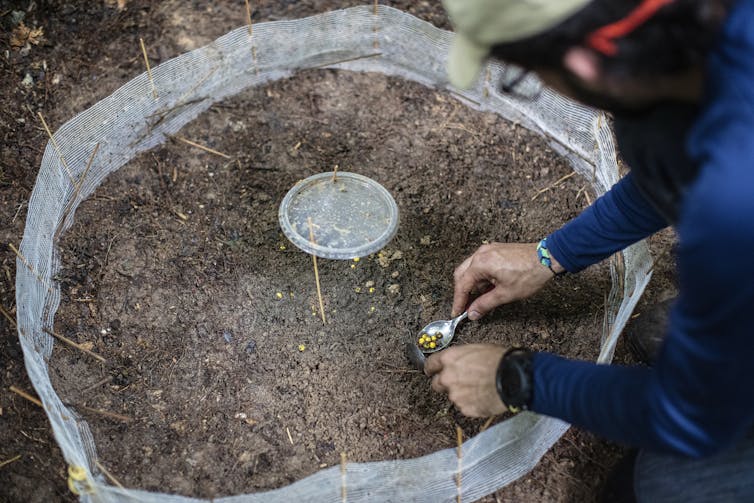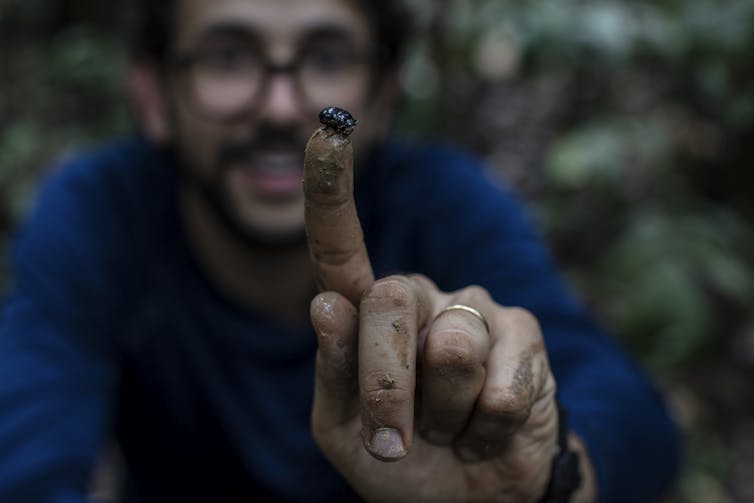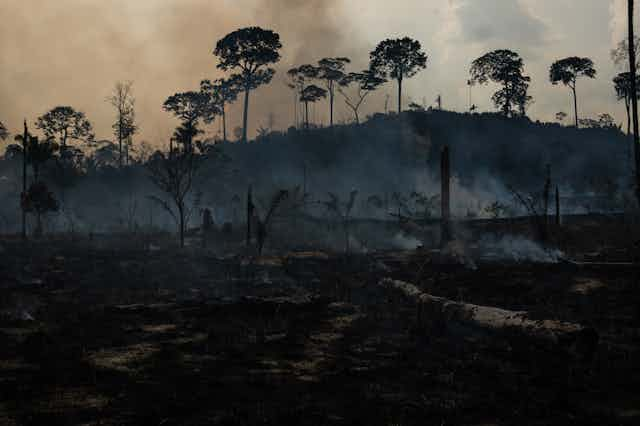The dung beetle may eat and nest in poop, but its role in nature is anything but humble.
These hardshelled scarabs live on every continent except Antarctica, recycling feces and suppressing parasites that could otherwise harm people and animals. Dung beetles also spread both seeds and nutrients into the soil, helping to maintain a healthy ecosystem.
Conversely, dung beetles suffer when an ecological system is struggling. In tropical forests, for example, stress caused by environmental disturbances causes dung beetles to gain body fat and work less. Species diversity declines.
That’s why, as Amazon researchers, we use the marvelous, hard-working dung beetle to measure the ecological health of the world’s largest rainforest. Since 2010, we have collected and studied over 14,000 dung beetles from 98 different species in the vast and still wild interior of Brazil’s Santarém region, a remote corner of the Amazon forest – part of a long-term project with the Sustainable Amazon Network.
Most recently, we studied dung beetles to assess the Amazon’s recovery from the intense drought and forest fires of 2015 and 2016, extreme climatic events brought on by the most severe El Niño on record.

Stressed beetles take less crap
Some forests in our 10,586-square-mile research area were burned in the El Niño fires, which scorched 4,000 square miles of the Amazon. These climate-triggered fires are not to be confused with last year’s Amazon fire crisis, which was deforestation-related. Other Amazonian forests in our study experienced extreme drought but not fire.
We knew going into this project that Amazonian fauna are particularly sensitive to fire – unlike animals in Australia, which have a long history of fire adaptation. But our study, which was published in the scientific journal Biotropica in February 2020, reveals that both forest fires and drought are far more damaging than previously thought.
Dung beetles are captured in traps baited with – what else? – human and pig poop. There we count and physically examine them. To assess their activity level, we trick dung beetles into dispersing seeds by building a small arena filled with a mix of dung and artificial seeds on the forest floor.

Comparing our catches before and after the El Niño forest fires, we learned that almost 70% of dung beetles had disappeared. We believe that’s because most dung beetles nest in shallow soil depths of between zero to 6 inches, so fire heat is likely to kill them.
The El Niño droughts likewise decimated the Amazonian dung beetle populations. Their populations dropped by about 60% in forests affected only by drought, not fire.
Together, extreme drought and forest fires in the Amazon had severely diminished the beetles’ ability to remove dung and spread seeds, which declined by 67% and 22%, respectively, in comparison to data recorded in 2010 – before El Niño. This reduced haul is probably the result of population loss.
Both the reduction in the number of dung beetles captured and their diminished waste disposal functions persisted even two years after El Niño. While dung beetle populations recover quickly in fire-dependent ecosystems, insect recovery from fire disturbance in tropical forests can take many years.

Tropical beetles
If both drought and fire kill off dung beetles, the Amazon forests are in serious trouble.
In damaged forests, most regrowth depends on seed dispersal by animals. Dung beetles disperse the seeds that promote revegetation and spread nutrients in the soil, helping seedlings survive.
They aren’t the only animals that play this critical ecological function. Tapirs, monkeys, ants, bee beetles and even wasps also spread the seeds that aid vegetation regrowth.
But many studies show that dung beetle responses to environmental stress are similar to those suffered by other seed-spreading animals necessary to tropical forest health. And climate change is likewise causing the collapse of these insect populations, killing off ants, bees, butterflies and wasps.
Without these important tropical animals, forests damaged by fire and drought will recover much more slowly. That means they may barely begin their regrowth before the next disaster. And with climate change projected to bring the tropics more intense and frequent droughts, along with hotter and dry global temperatures, such disasters will likely come ever more quickly.
From our field sites deep in the Amazon, we are rooting for all the little creeping and crawling creatures that keep the world running – with, admittedly, some particular affection and concern for the humble dung beetle.
[Like what you’ve read? Want more? Sign up for The Conversation’s daily newsletter.]

